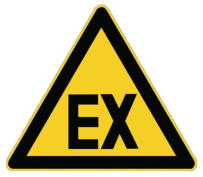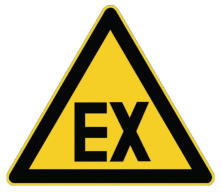
Explosion Testing for dust, gases & vapours


© March 2024
Classification test
Hazard classification test for combustible dust
The classification test offers a qualitative assessment of whether or not a suspended dust cloud is capable of initiating and sustaining an explosion in the presence of four different ignition sources; 10 KV electric spark, hot coil ignition and low energy chemical igniters. Explosion testing for hazard classification is made on a visual observation of flame propagation in the first two tests and on explosion pressure increase for the chemical igniters in an enclosed volume. The test is carried out to EN ISO/IEC 80079-20-2:2016 Explosive atmospheres - Part 20-2: Material characteristics -- Combustible dusts test methods and results in one of two possible outcomes: Group A (hazardous) - the dust cloud propagates flame from the ignition source and is classed as a combustible and potentially explosible material. Group B (non hazardous) - the dust cloud does not propagate flame from the ignition source and is classed as a non- combustible material. Group A dusts (combustible) may form Zone 20, Zone 21 and Zone 22 hazardous areas, depending upon the frequency and duration of the explosive atmosphere.
Classification test results


Material
Group
Hazard
GRP dust
Group A
Explosible
Flour (wheat)
Group A
Explosible
Sugar dust
Group A
Explosible


Explosion Testing


© March 2024
Classification test
Hazard classification test
for combustible dust
The classification test offers a qualitative assessment of whether or not a suspended dust cloud is capable of initiating and sustaining an explosion in the presence of four different ignition sources; 10 KV electric spark, hot coil ignition and low energy chemical igniters. Explosion testing for hazard classification is made on a visual observation of flame propagation in the first two tests and on explosion pressure increase for the chemical igniters in an enclosed volume. The test is carried out to EN ISO/IEC 80079- 20-2:2016 Explosive atmospheres - Part 20- 2: Material characteristics -- Combustible dusts test methods and results in one of two possible outcomes: Group A (hazardous) - the dust cloud propagates flame from the ignition source and is classed as a combustible and potentially explosible material. Group B (non hazardous) - the dust cloud does not propagate flame from the ignition source and is classed as a non-combustible material. Group A dusts (combustible) may form Zone 20, Zone 21 and Zone 22 hazardous areas, depending upon the frequency and duration of the explosive atmosphere.
Classification test results


Material
Group
Hazard
GRP dust
Group A
Explosible
Flour (wheat)
Group A
Explosible
Sugar dust
Group A
Explosible






















